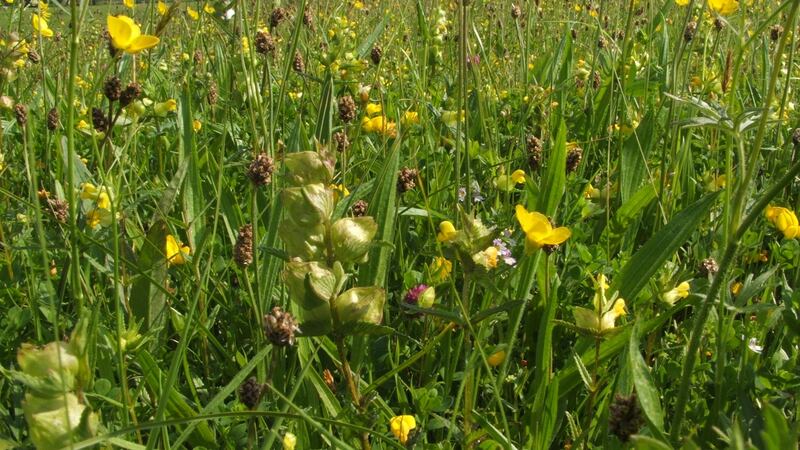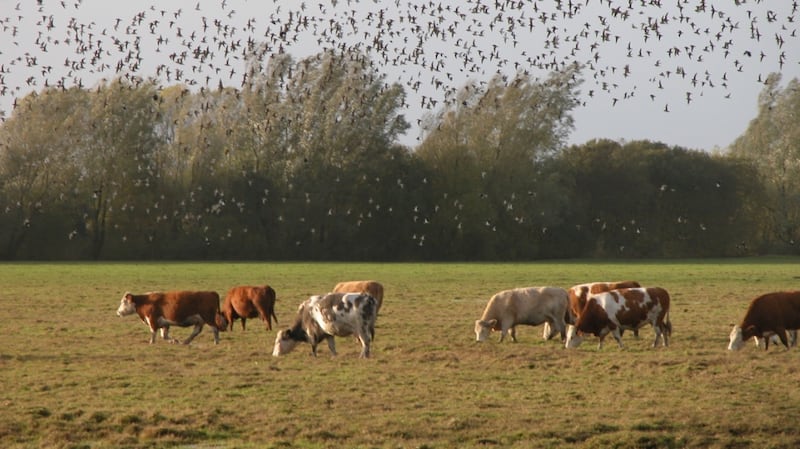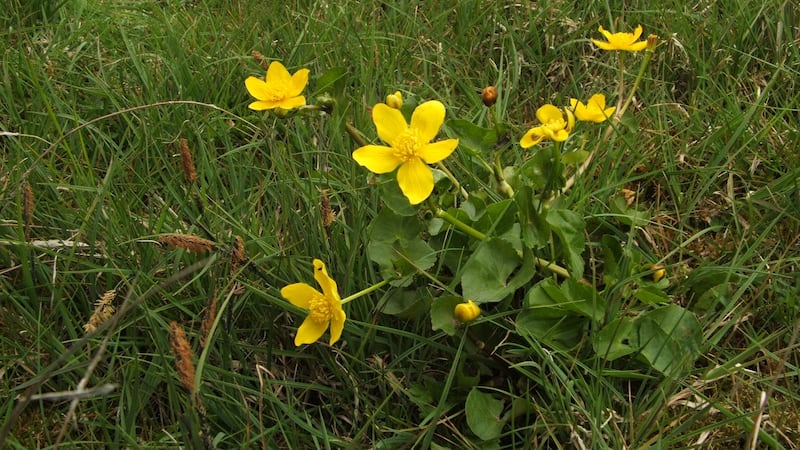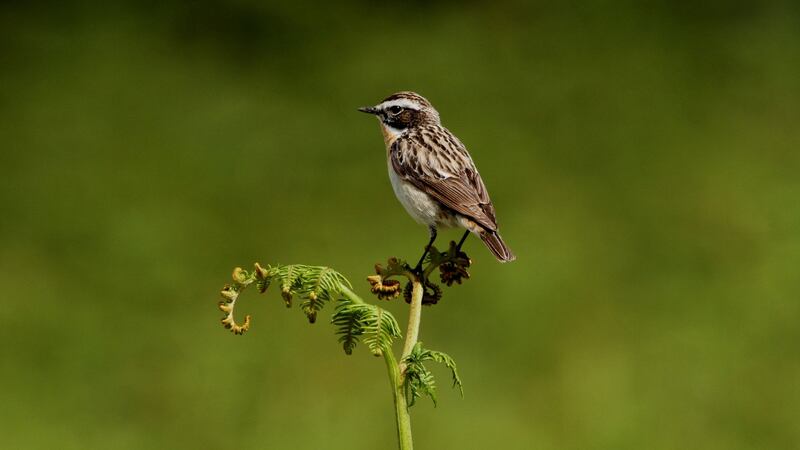There doesn’t seem to be anything at all remarkable about the field we are gazing across, though a great river must be flowing somewhere beyond it, since we are barely a mile from Shannon Harbour.
This field is flat, well cropped by pasturing cattle and horses. At first sight, you would not think that this is one of the best places in Ireland to see wintering water-birds.
But the evidence is before your eyes, even in high summer, if you know where to look for it. Stephen Heery does, and he finds it on an exposed rock near the gate: little stringy mats of dried out fibres.

"This is small lattice moss," he says. "It needs substantial but periodic flooding. This shows that winter floods reach all the way to this rock. This is the widest section of the Shannon Callows, 1.2km from the river in summer."
So, if you stood at this gate in winter, you might well hear the piercing whistles of a thousand wigeon whirling in to land on shallow water. You could see hundreds of leggy and elegant black-tailed godwits, probing the saturated meadow with their long, slightly upturned bills.
Unusual plants
We cross the pasture to a half-mowed hayfield. Again, it’s apparently unexceptional, until Heery begins picking out very unusual plants, like marsh pea and marsh stitchwort, among the standing grasses. This is just a taster for the next callow we will visit, which sparkles with a riot of wildflowers, and is home to some very rare breeding birds. In summer, too, this whole area is a largely unsung star of our natural heritage.
The callows (from “caladh” in Irish, meaning water meadow) form one of our most unusual landscapes, great expenses of hay meadow and cattle pasture, subject to seasonal inundation. They lie on either side of the most level land traversed by the meandering Shannon, between Athlone and Portumna. The adjacent Little Brosna (Ashton’s) Callows are equally rich in birds.
Manchán Magan rightly says that the midlands have a “strange allure”, packed with hidden jewels. This one has many facets, from the ancient monastery of Clonmacnoise to the myriad rare and common plants that bloom in profusion through the summer, from the arctic calls of wintering white-fronted geese to the liquid spring music of some of our last breeding curlew.


Heery is the author of a superb, and appropriately multi-faceted, natural history of the region, The Shannon Floodlands, beautifully illustrated by Gordon D’Arcy, among others. While researching it, he met two Botswanans in nearby Banagher during the winter floods.
Surveying the endless stretches of sodden, mostly treeless land, they remarked that the callows made them homesick. They felt they were looking out on the Okavango delta, except for the absence of giraffes. It’s a startling, but appropriate, analogy: a little bit of Africa in Ireland.
And until the recent past, a bird from Africa made the callows echo on summer nights with its charismatic, if most unmusical, mating call. In the 1990s, these meadows were the corncrake’s most promising Irish stronghold. Once common across the country, they were threatened with extinction by combine harvesters, which sliced and diced thousands of these ground-nesters, as our agriculture became mechanised and intensive.
In the callows, hay meadow ownership is based on narrow strips in unfenced fields running down to the river. (“Down” is relative, the slope is almost imperceptible). Each strip was generally harvested at slightly different times, maintaining diversity of habitat. Winter flooding also dictated later harvests than elsewhere, after the corncrake chicks had fledged.
Until a few years ago, many local farmers supported a scheme that rewarded consistently late mowing so that corncrakes could raise a second brood. The subsidy was small, and there was no additional compensation if summer flooding made late harvesting impossible.
Flooding
Brian Caffrey, who has monitored corncrakes here for BirdWatch Ireland, is waiting for us in the half-mown field. He says that callows farmers were very committed to saving a bird that they saw as emblematic of their home places.
But the scheme failed, because early summer flooding, once exceptional, increased dramatically, with a 10-year flood occurring several times in the early 2000s, and a 100-year flood as well, preventing the birds from breeding.

“The corncrake,” says Caffrey, “is one of the first Irish birds to become locally extinct due to climate change”. It survives, precariously, on our western islands.
This story of decline is repeated across many of the callows bird species since Heery’s landmark population surveys in the 1980s. White-fronted geese, once numerous in winter near Shannon Harbour, can now only be found on the Little Brosna Callows. The area’s four breeding waders, snipe, redshank, lapwing and curlew, are all in trouble, especially the latter, despite National Parks and Wildlife Service farm plans to support them.
Yet the area still holds places of magical natural luxuriance. Heery took me on to Lusmagh Callows near Banagher, into a hay meadow that was truly a field of botanical and birding dreams. He gave me a masterclass in how plant species change with micro-shifts in hydrology, geology and topography as the field approaches the Shannon.
At first, pink and purple devil’s-bit scabious is the most obvious flower among lovely purple moor-grass. It is soon replaced by great drifts of creamy sneezewort and yellow loosestrife, with some red dock seed heads standing proud. Then reed canary grass takes over, building into a wall that makes the Shannon, just 5m away, invisible.
Birds seem scarce at first, but Caffrey had mentioned that the callows holds 50 pairs of whinchat, 80 per cent of the whole Irish population of this small thrush.
A robin-sized bird displaying from a dock caught our eye. It had a smart white “eyebrow”, a delicate orange breast. Soon there were more, and then more, until we realised there were two entire families, adults with fledglings, on either side of us. It was a very special moment at the end of a special day.
The Shannon Floodlands by Stephen Heery is published by Tír Eolas, Newtownlynch, Co Galway.
Can the farmer and the callows still be friends?
Traditionally, farmers mowed their narrow callows hay strips at different times, creating mosaics of habitat that favoured the area’s rich biodiversity. But now it’s cheaper to hire contractors, using large machinery, to mow entire fields on the same day.
Kathryn Finney specialises in breeding waders for BirdWatch Ireland. Caitriona Maher researched the callows extensively for her PhD and managed a pilot scheme there, similar to the very successful Burren Farming for Conservation Programme, for two years.
Both say that Glas, the current national agri-environmental scheme, is inadequate to the exceptional richness and complexity of the area. Future schemes need to manage different parts of the callows for different habitats, and support farmers with the ecological expertise and financial resources to do this well.
Brendan McGarry’s family has farmed the callows for generations. “My grandfather taught me to work in harmony with nature,” he says. He expresses frustration with Department of Agriculture officials “who have never walked an inch of my land”, and come up with plans that do not work there.
In contrast, he praises BirdWatch Ireland staff for the intimate local knowledge they have developed, and clearly enjoys working with them.
“Everyone concerned for this area should sit down together and listen and learn from each other, with no one on their own particular power trip,” he says.











